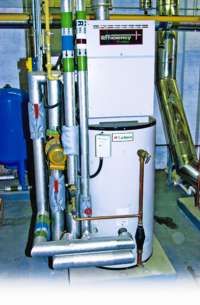The hot topic of water heating

A Lochinvar EPW15OCE Efficiency Plus water heater and LST70 storage tank complete with direct stacking frame replaced the existing kitchen hot water system at the Cedars School in Gateshead.
David Pepper considers the driving forces for efficient water heating and the opportunities in refurbishment projects.The Energy White Paper and Part L2 of the Building Regulations have presented specifiers and contractors with new challenges. Although the provision for hot water receives little mention in Part L2, water heating can represent a significant proportion of the total energy consumption in commercial and industrial buildings.
Refurbishment As well as meeting the requirements of the legislation, a refurbishment project can provide an ideal opportunity to dispose of old, inefficient equipment and install water heating plant to save both space and energy. Traditional indirect cylinders or calorifiers have heat-transfer losses, which result in slow heat up of water. They were thus frequently over-sized to meet hot-water demand. Standing losses are also greater as is the need for plant room space. Direct gas-fired water heaters generally take up less space, with copper-fin type units having the additional option of being ‘stacked’. To further assist refurbishment, pipework can be prefabricated and tested off site, before being broken down into smaller sections for easy delivery and on site installation.
Separately Hot water has traditionally been generated via an indirect cylinder or calorifier, with the energy source being the main central-heating boiler. However, the trend for separating heating and water-heating requirements and the use of direct gas-fired water heaters has offered more efficient solutions, particularly over the past 10 to 15 years. For space heating, the industry is being driven more and more towards condensing technology. Condensing boilers operate at very high efficiencies, with a return-water temperature of 43°C or less. However, the industry norm is to store hot water at 60°C or higher to prevent legionella colonisation. A condensing boiler is unlikely to operate at its best efficiency when generating hot water via a calorifier, so it makes even more sense to separate the generation of hot water from space heating boilers.
Condensing technology Both Government and industry pressures are pushing manufacturers to consider using condensing technology on direct gas-fired water heaters. Although the reasons are well intended and understandable, it is important to realise what happens to the efficiency of a condensing boiler or water heater if the return temperature is above dewpoint, i.e. 43°C. This fact is often not taken into consideration by specifiers, contractors and, particularly, those responsible for imposing legislation. Many products on the market see a dramatic decline in efficiency at higher return temperatures. As the requirement to store hot water is generally 65°C, it is important to be aware of the efficiency of a condensing water heater under these conditions. It is likely that a non-condensing high-efficiency water heater will operate just as efficiently as a condensing water heater on most installations.
High efficiencies Gas-fired storage water heaters were first used in the UK during the mid-1970s. By the early 1980s the more efficient high-output instantaneous direct-gas-fired water heater was introduced. These units achieve high efficiencies of 94% net without condensing, and their popularity has grown on larger commercial and industrial properties. Copper-fin products are among those available, and condensing versions can also be sourced, which will operate at efficiencies of 103% net at a return temperature of 65°C. This is a relatively small reduction on the 108% net efficiency where the system return temperature is 43°C. This 103% is achieved with a fully recuperative design and close control of the combustion process, which will not allow condensation to occur in the primary heat exchanger. An equally important consideration is the lifetime operating cost of water heaters, particularly in hard-water areas where scale formation can occur. Direct-gas-fired water heaters can be affected by scale, which may result in reduced life expectancy. However, even more importantly, a very small layer of scale formation will significantly reduce efficiency. Copper-fin units will operate free of scale due to their design. Life expectancy is prolonged and high operating efficiencies are maintained throughout the life of the product. To adapt to the ever-increasing demands to improve efficiencies as well as reducing carbon emissions as part of a refurbishment project, specifiers and contractors should look beyond ‘test house’ efficiencies. Consideration should be given to the situation and conditions in which the boiler/water heater will function to obtain a true picture of overall efficiency.
Important It is important that those responsible for applying legislation to our industry and those designing schemes such as Enhanced Capital Allowances (ECA) take time to examine the total operational efficiencies to encouraging energy efficiency and reduce carbon emissions.
David Pepper is managing director of Lochinvar Ltd, 7 Lombard Way, The MXL Centre, Banbury, Oxon OX16 4TJ.
Related articles:


